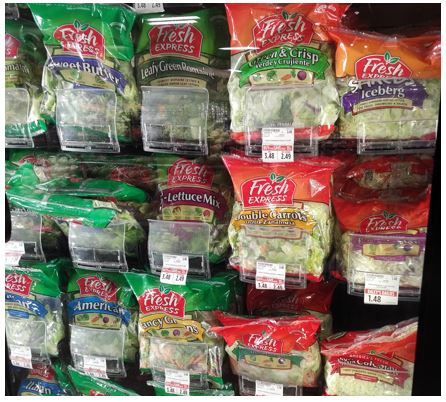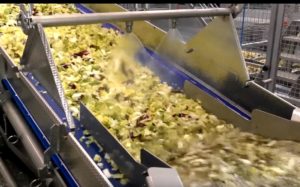I came across an interesting article in Medium, The History of Packaged Salad in 5 Minutes. Many of us purchase packaged salad blends or salad kits on a regular basis. Statista says that, in 2016, Americans purchased $964 million in salad blends and $950 million in salad kits. If you factor in cole slaw and other prepared salads, the total comes to almost $3.7 billion!
Americans love convenience! In fact, we’re now changing the face of convenience stores, long the bastion of junk food. Bucking past trends, produce sales in convenient stores are now about $242 million per year. In fact, according to a CNBC article “the amount of fruits and vegetables sold in the convenience stores has grown to be roughly the same as popcorn or pretzels.” Imagine stopping at a quickie mart or gas station convenience store and buying a salad kit and not thinking twice about it. That’s what millennials are doing…I’m not quite ready for that yet.
Salad kits with a mixture of lettuces, vegetables, proteins and dressings are certainly convenient but how do you know they are fresh and how can you manage shelf-life variability?
The History of Salad Kits
The Medium article says that there were three trends that defined the history of these increasingly convenient items.
- The 1950 and 1960s – Refrigerated supply chain and convenience: Post World War II began an era where people stopped growing their fresh produce and instead turned to grocery stores. And, with the development of the Interstate Highway System, transportation times from the west coast – where most of fresh produce comes from – to the east coast was cut in half. This meant that people on the east coast could begin to expect fresh produce from California, Arizona and Mexico year around. This, in turn, necessitated the creation of the cold supply chain – refrigerated trucks and refrigeration cases at our grocery stores.
- The 1970s: Ready to Eat: It seems that, once we get used to convenience, we crave it even more and the 1970s introduced us to ready-to-eat items like the infamous rotisserie chicken. Did you know that Costco sells about 60 million rotisserie chickens a year? Stores also started offering other take home and heat items.
- Late 1980s / early 1990s: The birth of value added produce: According to the Medium article Del Monte started this trend by shipping fresh pineapple pieces from Hawaii to the mainland. But, initially, the cold chain wasn’t really set up for this and they had a whopping 35 percent waste. They figured out how to solve that problem and other produce growers took notice.
Following this, the Taylor and Church families, two of the industry’s pioneers, from California’s central coast formed FreshExpress, the first major bagged or packaged salad company in Salinas. Originally these salad kits were mostly chopped head (iceberg) lettuce but that’s changed. Now packaged salads and kits include a variety of leafy greens and vegetables. In the late 1990s, Ready Pac introduced the Bistro Bowl, individual salad kits that included leafy greens, vegetables, condiments, protein, dressing, and the genius invention – the spork.
Salad Kits: Convenient but Are They Fresh?
Salad kits and commodity lettuces are processed differently from field to store.
- Commodities like head and non-processed leafy greens are field harvested and packaged. Workers cut the produce and celo-wrap or package it and then load it onto trucks where it is transported to the packing house for precooling and warehousing. It is not washed or processed.
- Processed lettuces for salad kits are similarly harvested but are transported in bins to the processing facility where it may be stored in a cold warehouse for a day or so and then the bins are emptied onto the processing lines. The ingredients that go into the salad kits are then washed (usually multiple times), cut or chopped into the desired sized pieces and bagged. Some leafy greens are, of course, not cut but washed and mixed.
So, what’s the shelf-life of these salad kits? Are they fresh? There are several things to consider with this. First is that, once a lettuce (like iceberg or romaine) is chopped/cut at a processing plant, the shelf-life is reduced because oxidation can occur where the cuts are made. Second, the shelf-life of the salad kit is only as good as its weakest ingredient.
For example, let’s say you buy a salad kit that has iceberg and romaine lettuce and carrots. If the iceberg has a remaining shelf-life of ten days, the romaine five days and the carrots a month, the shelf-life of the meal kit is five days because that’s when the first ingredient will spoil. Consumers aren’t likely going to pick out the good lettuce from the bad. They’ll toss the entire salad kit.
Manage the Variability
The best way to solve this problem is to manage for the variability of the ingredients in the salad kit. This is important because shelf-life variability begins at harvest in the field due to harvest conditions, the individual products and post-harvest processing. It can take several hours to load a truck full of pallets and, for every hour lettuce spends in field heat, it can lose a full day of shelf-life.
Let’s say the processor is receiving iceberg from one supplier and romaine from another. That’s all put into a warehouse. Do we know the respective shelf-lives of the ingredients? What if all of the iceberg has one shelf-life and the romaine has half as much? Wouldn’t you want to be able to match bins with like bins that share the same shelf-life? That is, the iceberg and romaine going into the salad kit both have ten days instead of a mix.
Pallet-level monitoring of the lettuces, from the field to the processor, enables the processor to know the dynamic shelf-life of each bin of lettuce – not the truck load – each bin. This can help prioritize processing including precooling and also provide the ability to match similarly aging ingredients to ensure uniform, and knowable, shelf-life.
Similarly, once processed, each pallet can be monitored from that point through to the retail customer or restaurant to ensure for cold chain integrity and to provide the retailer with the dynamic shelf-life of the salad kits they’re receiving.
Zest Fresh provides the ability for processors to manage this variability, from field to processing and processing to store.
If you’ve never had the opportunity to see a produce processing plant, they’re quite amazing. Some of the processors do offer tours and there are some videos available.
Note: The blog photo is from the grocery store I shop at regularly. There’s no intent to imply any quality issue related to the products in the display case.



